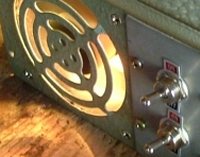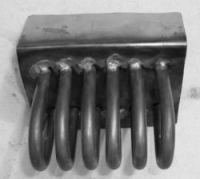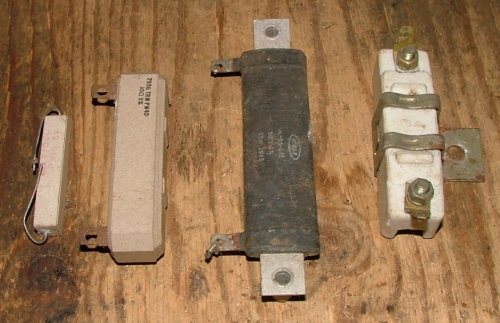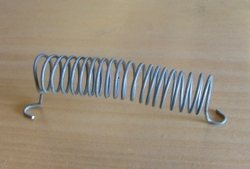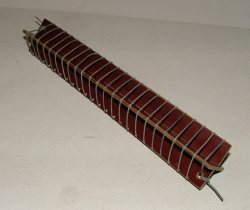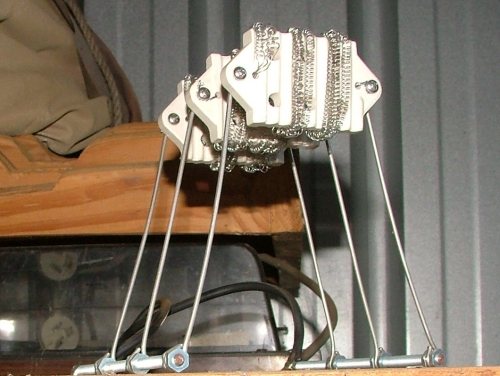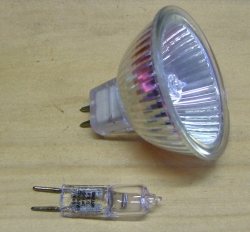 |
|
|
Site Navigation
Projects & Information
»General Information»Wind turbine Projects »The F&P Smartdrive »Electronic projects »Microcontroller projects »Miscellaneous Kits & Parts
»Basicly Natural Pty Ltd»PVC & Aluminium blades »Scale model farm windmills »Price Watch Discussion Forums
Handy Links
»Wind»Solar »Electric Vehicles »Electronics »Micro Controllers »General Interrest About TheBackShed Getting Started Privacy Policy |
We could use the extra power to do something useful, like heat water, but in most situations we just need a device that can drain power safely and reliably. Most dump loads turn electrical power into heat, and depending on the size of the dump load, need to some way to dissipate this heat. Turning electrical power into heat is a simple task, we use something called a resistor ( symbol The current flowing through a resistor is worked out with ohms law. If we know any two variables, we can work out the third.
So, for example, if we have a 2 ohm resistor, and apply 12 volts, it will draw 6 amps. If I needed to dump 10 amps, I can work out what resistance I need for my dump load using 12 volts / 10 amps giving a 1.2 ohm resistor. Easy, go and buy a 1.2 ohm resistor. Not so fast! That 1.2 ohm resistor will drain 10 amps from your 12 volt supply, but where does that 10 amps go? Answer - Heat! And lots of it. Heat is power, and we measure power in Watts. To work out Watts, we use....
Back to our 1.2 ohm resistor. At 12 volts its soaking up 10 amps, so 12 volts X 10 amps is 120 watts. The resistor needs to dissipate 120 watts of heat into its surroundings. Is 120 watts a lot? That depends on how big the area dissipating the 120 watts is. If its as big as a fry pan, you could put you hand on it and it would feel warm. If its the size of a grain of salt, it will melt steel and vaporize timber ( this is how a 300 watt laser cutter can cut 3mm steel plate, the energy is focused to a fine point. Ever used a magnifying glass to burn paper?). So as a rule, the bigger the resistor, the more heat ( watts ) it can dissipate. Commercial resistors are designed to dissipate a certain amount of heat. The little resistors in you pocket radio will dissipate 1/4 of a watt, not much, we would need 480 little resistors to dissipate our 120 watts. Fortunately we can get higher wattage resistors.
From left to right we have a 10 watt, 40 watt, and two 50 watt resistors. The resistor to the far right is a ballast resistor from a car. To dissipate our 120 watts, we could use 3 of the 40 watt resistors, or better still, 3 of the 50 watt resistors, to give us some breathing space. Its a good idea to have a higher rated resistor then we need because the watts will go up if the voltage goes up. We calculated the wattage based on 12 volts, but if the source voltage went up to 13 volts, we would need to dissipate 140 watts. While we can use as many high watt resistors as needed, they can get expensive. What cheaper options are there?
|
|||||||||||
Building your own high watt resistor. The dump resistor below was made from 3 electric jug elements. The wire resistance on each element was 10 ohms, and 10 ohms across 12 volts only draws 1.2 amps. I unwound the heater wire and cut into 4 even lengths, where were then joined up in parallel before re-winding onto the ceramic insulator. This gave a resistance of 2.5 ohms, which would draw 4.8 amps, at 50 watts. There are 3 elements connected in parallel, so this contraption ended up a 150 watt dump load. It gets very hot, I should have it covered.
Light Bulbs...
This spike only lasts a few milliseconds, but it could still be long enough to damage the switching circuit. The other concern is a light bulb can blow if the input voltage is too high. A blown bulb is open circuit, and no longer provides any form of dump load protection to your battery bank or windmill. |
||||||||||||
